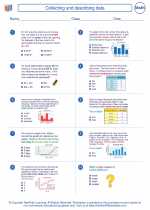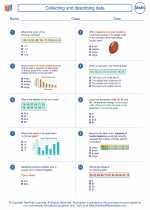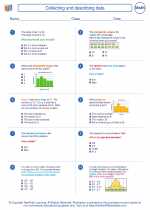Graphical Representation of Data
Graphical representation of data involves presenting information in a visual form such as graphs, charts, and diagrams. It is a powerful tool for analyzing and interpreting data, making it easier to understand and identify patterns, trends, and relationships within the data.
Types of Graphs
There are several types of graphs commonly used to represent data:
- Bar Graphs: Used to compare data across different categories.
- Line Graphs: Show the relationship between two variables over time or other continuous intervals.
- Pie Charts: Display the parts of a whole and show the proportion of each category relative to the entire data set.
- Scatter Plots: Depict the relationship between two variables, with each point representing a different pair of values.
- Histograms: Used to show the distribution of a continuous variable by dividing it into intervals.
Choosing the Right Graph
When selecting a type of graph to represent data, it's important to consider the nature of the data and the purpose of the representation. For example, if you want to compare quantities across different categories, a bar graph would be appropriate. If you want to show the trends over time, a line graph would be more suitable.
Key Concepts to Understand
To effectively create and interpret graphical representations of data, it's important to understand the following key concepts:
- Variables: The factors being measured or compared in the data.
- Axis and Scales: The x-axis and y-axis provide the framework for the graph, and the scale determines the intervals and units used.
- Labels and Titles: Proper labeling and titling of the graph are essential for clarity and understanding.
- Trends and Patterns: Identifying trends, patterns, and relationships within the data is crucial for drawing meaningful conclusions.
Study Guide
To master the graphical representation of data, here are some study guide tips:
- Understand the different types of graphs and their specific uses.
- Practice creating graphs from given sets of data, ensuring proper labeling and scaling.
- Learn to interpret graphs and extract meaningful information from them, such as trends, comparisons, and distributions.
- Explore real-world examples of graphical data representation to understand how it is used in various fields.
- Review key concepts such as variables, axis, scales, labels, and patterns to ensure a comprehensive understanding of the topic.
By mastering the graphical representation of data, you will gain a valuable skill for analyzing and communicating information effectively.
[Graphical Representation Of Data] Related Worksheets and Study Guides:
.◂Math Worksheets and Study Guides Eighth Grade. Collecting and describing data

 Worksheet/Answer key
Worksheet/Answer key
 Worksheet/Answer key
Worksheet/Answer key
 Worksheet/Answer key
Worksheet/Answer key
